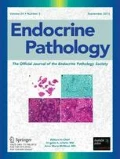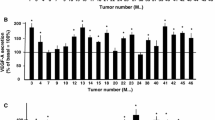Abstract
Hypoxia-inducible factor (HIF)-1α is a transcription factor in hypoxia adaptation mechanisms. In malignant tumors, HIF-1α upregulates vascular endothelial growth factor (VEGF) expression to induce tumor angiogenesis. Although VEGF and HIF-1α are expressed in pituitary adenomas, the relationships of these factors remain unclear. Therefore, we examined the expression of HIF-1α and VEGF using real-time RT-PCR and immunohistochemistry to clarify the relationship of these factors in pituitary adenomas. HIF-1α mRNA and VEGF mRNA levels in pituitary adenoma tissues from 25 operated patients were quantified using real-time RT-PCR. Some tissues were also studied by double fluorescent immunohistochemical methods. HIF-1α mRNA and protein were expressed in all pituitary adenomas examined. Their expression tended to be higher in GH-producing and lower in ACTH-producing tumors. VEGF mRNA and protein were also expressed in all pituitary adenomas. There was no significant correlation in the expression levels of HIF-1α and VEGF mRNA. The mutual expression of HIF-1α and VEGF was of no significance; in only a few cells were HIF-1α and VEGF co-localized. Our results suggest that in pituitary adenomas VEGF expression may not depend strongly on HIF-1α expression.
Similar content being viewed by others
References
Hockel M, Vaupel P. Biological consequences of tumor hypoxia. Semin Oncol 28:36–41, 2001.
Hockel M, Vaupel P. Tumor hypoxia: definitions and current clinical, biologic, and molecular aspects. J Natl Cancer Inst 93:266–276, 2001.4. 4.
Kayama T, Yoshimoto T, Fujimoto S, Sakurai Y. Intratumoral oxygen pressure in malignant brain tumor. J Neurosurg 74:55–59, 1991.
Rofstad EK. Microenvironment-induced cancer metastasis. Int J Radiat Biol 76:589–605, 2000.
Brat DJ, Mapstone TB. Malignant glioma physiology: cellular response to hypoxia and its role in tumor progression. Ann Intern Med 138:659–668, 2003.
Zagzag D, Friedlander DR, Margolis B, et al. Molecular events implicated in_brain tumor angiogenesis and invasion. Pediatr Neurosurg 33:49–55, 2000.
Zagzag D, Nomura M, Friedlander DR, et al. Geldanamycin inhibits migration of glioma cells in vitro: a potential role for hypoxia-inducible factor (HIF-1 alpha) in glioma cell invasion. J Cell Physiol 196:394–402, 2003.
Zhong H, De Marzo AM, Laughner E, et al. Overexpression of hypoxia-inducible factor 1 alpha in common human cancers and their metastases. Cancer Res 59:5830–5835, 1999.
Kristof RA, Aliashkevich AF, Hans V, et al. The regional oxygen saturation of pituitary adenomas is lower than that of the pituitary gland: microspectrophotometric study with potential clinical implications. Neurosurgery 53:880–885, 2003.
Fukui S, Otani N, Nawashiro H, et al. The association of the expression of vascular endothelial growth factor with the cystic component and haemorrhage in pituitary adenoma. J Clin Neurosci 10:320–324, 2003.
Lloyd RV, Scheithauer BW, Kuroki T, Vidal S, Kovacs K, Stefaneanu L. Vascular endothelial growth factor (VEGF) expression in human pituitary adenomas and carcinomas. Endocr Pathol 10:229–235, 1999.
Nishikawa R, Cheng SY, Nagashima R, Huang HJ, Cavenee WK, Matsutani M. Expression of vascular endothelial growth factor in human brain tumors. Acta Neuropathol (Berl) 96:453–462, 1998.
Vidal S, Horvath E, Kovacs K, Kuroki T, Lloyd RV, Scheithauer BW. Expression of hypoxiainducible factor-1 alpha (HIF-1 alpha) in pituitary tumours. Histol Histopathol 18:679–686, 2003.
Weidner N, Carroll PR, Flax J, Blumenfeld W, Folkman J. Tumor angiogenesis correlates with metastasis in invasive prostate carcinoma. Am J Pathol 143:401–409, 1993.
Kim K, Arai K, Sanno N, Teramoto A, Shibasaki T. Ghrelin and growth hormone (GH) secretagogue receptor (GHSR) mRNA expression in human pituitary adenomas. Clin Endocrinol 54:759–768, 2001.
Semenza GL. Hypoxia-inducible factor 1: master regulator of O2 homeostasis. Curr Opin Genet Dev 8:588–594, 1998.
Iyer NV, Kotch LE, Agani F, et al. Cellular and developmental control of O2 homeostasis by hypoxia-inducible factor 1 alpha. Genes Dev 12:149–162, 1998.
Jiang BH, Agani F, Passaniti A, Semenza GL. V-SRC induces expression of hypoxia-inducible factor 1 (HIF-1) and transcription of genes encoding vascular endothelial growth factor and enolase 1: involvement of HIF-1 in tumor progression. Cancer Res 57:5328–5335, 1997.
Yamada S, Takada K. Angiogenesis in pituitary adenomas. Microsc Res Tech 1:236–243, 2003.
Brizel DM, Scully SP, Harrelson JM, et al. Tumor oxygenation predicts for the likelihood of distant metastases in human soft tissue sarcoma. Cancer Res 56:941–943, 1996.
Schwickert G, Walenta S, Sundfor K, Rofstad EK, Mueller-Klieser W. Correlation of high lactate levels in human cervical cancer with incidence of metastasis. Cancer Res 55:4757–4759, 1995.
Fujii T, Otsuki T, Moriya T, et al. Effect of hypoxia on human seminoma cells. Int J Oncol 20:955–962, 2002.
Krishnamachary B, Berg-Dixon S, Kelly B, et al. Regulation of colon carcinoma cell invasion by hypoxia-inducible factor 1. Cancer Res 63:1138–1143, 2003.
Viacava P, Gasperi M, Acerbi G, et al. Microvascular density and vascular endothelial growth factor expression in normal pituitary tissue and pituitary adenomas. J Endocrinol Invest 26:23–28, 2003.
Ryuto M, Ono M, Izumi H, et al. Induction of vascular endothelial growth factor by tumor necrosis factor alpha in human glioma cells. Possible roles of SP-1. J Biol Chem 271:28220–28228, 1996.
Seghezzi G, Patel S, Ren CJ, et al. Fibroblast growth factor-2 (FGF-2) induces vascular endothelial growth factor (VEGF) expression in the endothelial cells of forming capillaries: an autocrine mechanism contributing to angiogenesis. J Cell Biol 141:1659–1673, 1998.
Gloddek J, Pagotto U, Paez Pereda M, Arzt E, Stalla GK, Renner U. Pituitary adenylate cyclase-activating polypeptide, interleukin-6 and glucocorticoids regulate the release of vascular endothelial growth factor in pituitary folliculostellate cells. J Endocrinol 160:483–490, 1999.
Lohrer P, Gloddek J, Hopfner U, et al. Vascular endothelial growth factor production and regulation in rodent and human pituitary tumor cells in vitro. Neuroendocrinology 74:95–105, 2001.
McCabe CJ, Boelaert K, Tannahill LA, et al. Vascular endothelial growth factor, its receptor KDR/Flk-1, and pituitary tumor transforming gene in pituitary tumors. J Clin Endocrinol Metab 87:4238–4244, 2002.
Fan L, Iseki S. Immunohistochemical localization of vascular endothelial growth factor in the endocrine glands of the rat. Arch Histol Cytol 61:17–28, 1998.
Zagzag D, Zhong H, Scalzitti JM, Laughner E, Simons JW, Semenza GL. Expression of hypoxia-inducible factor 1 alpha in brain tumors: association with angiogenesis, invasion, and progression. Cancer 88:2606–2618, 2000.
Jiang BH, Semenza GL, Bauer C, Marti HH. Hypoxia-inducible factor 1 levels vary exponentially over a physiologically relevant range of O2 tension. Am J Physiol 271:1172–1180, 1996.
Author information
Authors and Affiliations
Corresponding author
Rights and permissions
About this article
Cite this article
Kim, K., Yoshida, D. & Teramoto, A. Expression of hypoxia-inducible factor 1α and vascular endothelial growth factor in pituitary adenomas. Endocr Pathol 16, 115–121 (2005). https://doi.org/10.1385/EP:16:2:115
Issue Date:
DOI: https://doi.org/10.1385/EP:16:2:115




